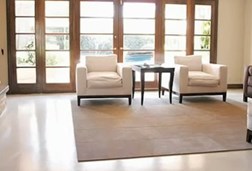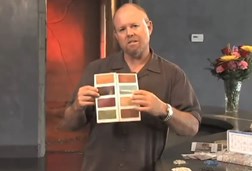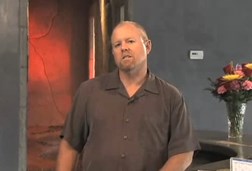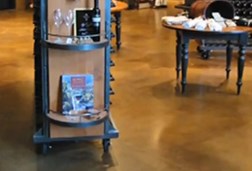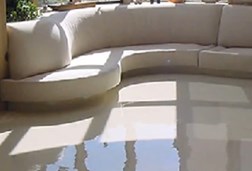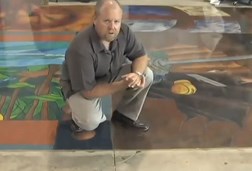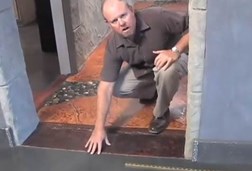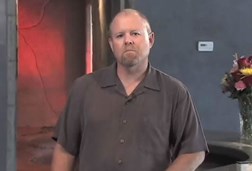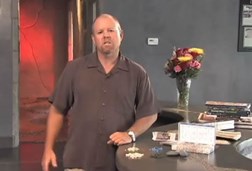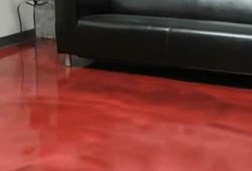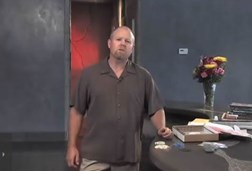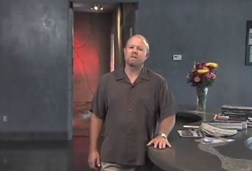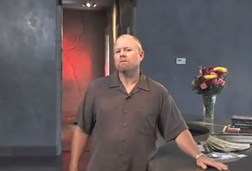- Design Idea Videos
- Floor Type Videos
- Common Question Videos
- Why Concrete Floors?
- Replacing Existing Floors
- Choosing a Floor Contractor
- Floor Maintenance Videos
- More Concrete Videos
- Floor Videos
- Countertop Videos
- Outdoor Living Videos
- Furniture Videos
- Demonstration Videos
- Concrete Tool Videos
- Concrete Stain Videos
- Sealer Videos
- Concrete Stencil Videos
- Concrete Stamps Videos
- Surface Preparation Videos
- Concrete Forms Videos
Concrete Floor Videos
"Floor Me" Video Series with Bob HarrisConcrete floors offer numerous options in design, color and texture. Click on the videos below to get advice from Bob Harris on the design styles available for concrete flooring, including details of which styles are most conducive for various environments.
Stained Concrete Floors-Ideas for Concrete Stains
Time: 01:54
Bob Harris introduces you to the myriad ways you can dress up your concrete floors with chemical stains and dyes. Stains and dyes can be applied to new or old and plain or colored concrete, in both residential and commercial settings. They are popular in kitchens, family rooms, retail stores, restaurants, sports stadiums and even for garage and basement floors. With both stains and dyes, the color becomes a permanent part of the concrete and won't wear away or require reapplication.
For more information see:
Staining Concrete
Concrete Dyes Expand the Color Palette of Concrete Stains
Images used in video provided by Colormaker Floors, Progressive Concrete Coatings, Kemiko Decorative & Industrial Floor Finishes, & Bomanite.
Staining Concrete Offers Design Versatility
Time: 02:29
Harris explains his tools and techniques for achieving special effects with stains and dyes and the various ways you can personalize your floor. Because stains accent the natural characteristics of concrete, they result in an organic look with a rich patina. The warm, variegated coloring effects blend particularly well with Old World or Tuscan-style decor.
For more information, read What Special Effects Are Possible with Concrete Stains?
Images in this video provided by Westcoat, Flying Turtle Cast Concrete, Colormaker Floors, Kemikoating Surfaces, & Modello Designs.
Limitations of Concrete Acid Stains
Time: 02:58
Many people love the natural color variations produced by acid-based chemical stains, but they do have some limitations, such as a limited palette of earth-toned colors and unpredictable coloring effects. Harris discusses how to overcome some of these limitations by pairing chemical stains with dyes or by using water-based stains. Using concrete dyes or water-based stains allows you to tap into a broader range of colors. Dyes can also be used to fix problem areas where chemical stains haven't taken.
For more information see:
Water-Based Penetrating Stains
Images in this video provided by Concretizen & L.M. Scofield.
Using Concrete Stain with Overlays
Time: 03:04
Because stains and dyes have some transparency and aren't entirely opaque, they won't be able to mask flaws in an existing concrete floor, such as heavy rust or oil stains and plumbing or electrical line repairs. To get around this problem, Harris explains how to use overlays or skim coats to create a new canvas for stain and dye application. This will give you total design flexibility, and allow such options as decorative sawcuts and multiple fields of color.
For more information see:
Decorative Concrete Overlays
Images provided by Progressive Hardscapes and Colormaker Floors.
Self-Leveling Overlays for Concrete Floors
Time: 01:16
Harris discusses the advantages of using self-leveling overlays to restore structurally sound yet worn concrete or to level uneven floors. Because these overlays are typically applied at thicknesses of 1/4 inch or greater, they effectively cover minor flaws and compensate for height variances.
For more information, see self-leveling concrete overlays or more types of overlays.
Images in this video provided by Colormaker Floors.
Considerations When Using a Self-Leveling Floor Topping
Time: 01:30
Harris discusses the factors to consider before using a self-leveling overlay to cover an existing floor:
- Because these overlays are typically applied at thicknesses of 1/4 inch or greater, they are heavier than thinner overlays or toppings. Be sure the floor is structurally sound and can bear the extra weight of the overlay, especially if going over wood.
- Self-leveling overlays are less flexible after drying than microtoppings and spray-down systems, which can make them more prone to cracking.
Some images in this video provided by Westcoat.
When to Use a Decorative Overlay
Time: 02:50
Decorative overlays and microtopppings are ideal for masking flaws in existing concrete floors, such as stains and hairline cracks. Harris gives examples of when, and when not, to use them:
- When you want to start with a clean canvas.
- When you want to achieve special textural effects not possible with plain concrete.
- When you want to cover other types of sound floor surfaces, such as wood, vinyl tile and linoleum.
- An overlay should not be placed over major cracks or severe spalling without prior restoration.
How to Select the Proper Thickness for Your Concrete Overlay
Time: 02:55
Overlay thicknesses vary from about 1/8 inch (for a microtopping or skim coat) to ¾ inch for a stampable overlay. Harris shows several examples of how to adjust for transitions between floors when overlays are applied. If you want to maintain a seamless transition between rooms, thinner overlays can go down to a featheredge, so they won't create a noticeable height difference.
Create a Blank Canvas before Coloring Your Concrete Floor
Time: 02:22
After assessing the condition of your floor, you may decide it's necessary to apply an overlay to the concrete surface prior to staining. One option is to use a self-leveling product. Bob Harris explains how to use these overlays as a blank canvas for a wide variety of decorative embellishments. Not only can pigments be added to the mix to achieve nearly any shade desired, self-leveling overlays can be further enhanced by chemical or water-based stains, dyes or tints after the surface hardens. The overlay can be also be used as a canvas for sawcut or engraved designs.
Introduction to Polished Concrete
Time: 02:01
Why are more homeowners, retailers, architects and engineers choosing polished concrete as their finished floor of choice? Here, Bob Harris tells us the reasons why polished concrete is becoming one of the most sought-after hard surfaces, including aesthetics, uniqueness, ease of maintenance and light reflectivity. Polished concrete is a good alternative for homeowners or businesses that can't afford marble or granite floors but want the same brilliant, mirror-like finish.
Images in this video provided by Colorado Hardscapes, HTC America, & Westcoat.
Polishing Concrete - Get Design Options
Time: 04:25
Perhaps the most desirable feature of polished concrete is the endless array of decorative options available. Harris discusses how this complete design flexibility can produce stunning floors that are totally unique. Depending on the polishing abrasives and procedures used, it's possible to achieve different ranges of polish and different levels of sheen, from matte to a glassy mirror-like finish. The choices of color, pattern and texture are also unlimited. Harris demonstrates how to embed objects into the freshly placed concrete and, through the sequence of grinding and polishing, expose them to create additional visual drama.
Images used in this video provided by L&M Construction Chemicals, Concrete Treatments Inc., & Polished Concrete Systems Inc.
Best Types of Concrete Floors to Polish
Time: 01:29
Although nearly any structurally sound concrete floor can be polished, Harris identifies a few of the exceptions:
- Freshly placed concrete. You must wait until the concrete has cured to sufficient hardness before polishing.
- Existing floors that need extensive patching or are extremely soft and porous.
- Badly spalled surfaces. You'll need to remove the surface layer of concrete using a scarifier before going over the floor with polishing and grinding equipment.
When Should You Use an Epoxy Floor Coating?
Time: 01:30
Another option for covering sound, properly prepared concrete floors is an epoxy coating, especially if you want a surface that's highly resistance to tire marks and chemicals and can be tinted nearly any color-even bright, intense shades. Bob Harris discusses the most popular applications for epoxy coatings and their chief attributes, such as durability, longevity and minimal maintenance.
Epoxy & Garage Floor Coating Design Options
Time: 03:36
As with overlays, the color and design possibilities with epoxy coatings are unlimited. Harris describes some of the possibilities:
- An epoxy coating can be tinted nearly any color, even intense shades such as crimson red. Metallic and light-refracting pigments are also available.
- For more color or sparkle, the epoxy matrix can be broadcast with colored paint chips or decorative aggregates, such as colored quartz.
- You can use divider strips of metal or colored plastic as accents and to separate different colors of epoxy.
Images in this video provided by Westcoat & Yezco Concrete Polishing.
Drawbacks of Epoxy Floor Coatings
Time: 01:37
The biggest drawback of epoxy coatings is that they don't "breathe," so they will trap any moisture vapor coming up from the concrete slab. Before applying an epoxy, Harris recommends having your floor tested first for the moisture-vapor emission rate. If the rate is too high, the epoxy topping can delaminate.
To learn more, view Harris's video on testing concrete for moisture vapor.
Why Use Concrete Floor Tile
Time: 01:41
A unique flooring material gaining in popularity is precast concrete tile, which can mimic ceramic tile or natural stone but is more environmentally friendly and offers unlimited design options. Harris explains some of the ways these tiles can be customized to suit your décor.
Read more about concrete tile.
Images in this video provided by Buddy Rhodes Concrete Products, Sanoma Cast Stone & Smith Laredo Specialty Surfaces.
Best Places to Install Concrete Floor Tiles
Time: 02:12
Concrete floor tiles are available in an endless array of colors, shapes and textures, ranging from smooth to embossed. Popular applications include bathroom floors, shower floors, entryways, hallways and kitchens. Harris says the key considerations are exposure to traffic and maintenance requirements. Applying a sealer to the tiles will help protect them from stains and harsh cleaners.
Images in this video provided by Buddy Rhodes Concrete Products, Sanoma Cast Stone & Smith Laredo Specialty Surfaces.

